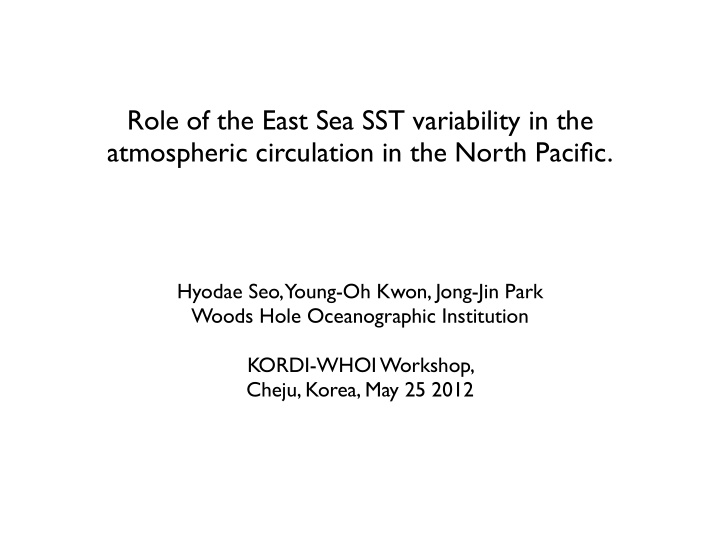



Role of the East Sea SST variability in the atmospheric circulation in the North Pacific. Hyodae Seo, Young-Oh Kwon, Jong-Jin Park Woods Hole Oceanographic Institution KORDI-WHOI Workshop, Cheju, Korea, May 25 2012
SST variability in the East Asian Marginal Seas is important for regional weather. In the East/Japan Sea, the warm transport by the Tsushima Warm Current influences wintertime SST and precipitation. Correlation Correlation SON TWC Transport and DJF Precip. SON TWC Transport and DJF SST p i c m e r r a P W r e t a r t m n o i p W i h s n s u a s r T T t n n m e r u r t u u C A Hirose et al. 2009
Presumably, the marginal sea processes would also play some role in the downstream North Pacific circulation. Correlation SON TWC transport and HGT 500mb HGT500mb response 2003 (cold) minus 2005 (warm) EJS SST Yamamoto and Hirose 2011 Hirose et al. 2009 TWC and its representation on SST have some connection to the large-scale atmospheric circulation pattern.
Climatology Dominant modes of wintertime SST variability NDJFMA identified from the NOAA OISST (25 km, daily,1982-2010) EOF1 PC1 • Basin-wide warming/ 42% normalized SST cooling and a shift in front ≈ Interannual 1st CEOF in Minobe (2004) EOF2 PC2 18% • Dipolar pattern in SST normalized SST anomalies ≈ Decadal 1st CEOF in Minobe (2004)
Main question: How will these two dominant modes of SST anomaly patterns EOF1 EOF2 impact the regional and large-scale circulation patterns? And are the circulation response symmetric with respect to the sign of SST anomaly pattern?
Regional atmospheric model simulation Lateral BC: NCEP 6-hourly climatology • Model: WRF 3.3 • Lower BC: • NOAA daily climatology 1982-2010 d01: 180km • Lateral BC: • NCEP 6-hourly climatology 1980-2010 Two-way feedback • 6 month integration: Nov.-Apr. d03: 12km • CTL, EOF1P , EOF1M: 40-member • EOF2P , EOF2M: 20-member d02: 60km • Focus on November-January response Two-way feedback • Initial adjustment period • Quasi-equilibrium state EOF2M CTL EOF1M EOF2P EOF1P
1. SLP responses for the different time-scale and ensemble averaging
A deterministic SLP response to the diabatic forcing in 1-14 days EOF1P-CTL Ensemble member 11-20 Ensemble member 1-10 Ensemble mean 1-40 Ensemble member 31-40 Ensemble member 21-30 L [mb]
A chaotic quasi-equilibrium response in 15-91 days due to the circulation change. EOF1P-CTL Ensemble member 11-20 Ensemble member 1-10 Ensemble mean 1-40 Ensemble member 21-30 Ensemble member 31-40 [mb]
Some robust and significant SLP response emerge as more ensemble members are used for averaging. 1-10 member mean EOF1P-CTL 1-20-member mean 15-91 day 1-30 member mean 1-40 member mean Black contours: significant at 95%
2. Local response in precipitation in NDJ (15-91 day)
15-91 day averaged responses in precipitation, SLP , and surface wind mm/day PRECIP mm/day PRECIP EOF1P-CTL EOF1M-CTL SST SST mb SLP/WIND SLP/WIND mb H L A symmetric rainfall response to the polarity of rainfall, but not in SLP .
15-91 day averaged responses in precipitation, SLP , and surface wind mm/day mm/day PRECIP PRECIP EOF2P-CTL EOF2M-CTL SST SST mb mb SLP/WIND SLP/WIND L H
3. Downstream responses in atmospheric circulation
The initial baroclinic response is followed by an equivalent barotropic structure Time-series of pattern correlation in geopotential height anomaly at 200mb and 850mb Correlation Coefficient Equivalent barotropic EOF1P-CLIM EOF1M-CLIM 14 days Baroclinic initial response and a fast transition toward the barotropic structure
An equivalent barotropic height response meter 200 mb HGT EOF1P-CTL L H • High in the Pacific Northwest. • Low over Kamchatka Peninsula meter 850 mb HGT L H Black contours: significant at 95% 40-member ensemble mean
There are common circulation responses regardless of the SST forcing. EOF1P-CTL EOF1M-CTL Showing responses in Tair, 10m-wind and SLP H L H L H • Responses are distinct over forcing region, depending on 40 members 40 members the sign of diabatic forcing. EOF2P-CTL EOF2M-CTL • SLP High in the H L H Pacific NW and Low over the Kamchatka Peninsula are shown as somewhat common feature. 20 members 20 members
Summary • Two dominant modes of wintertime SST variability produce differing circulation responses during the two periods of • Initial adjustment : a deterministic and baroclinic response to the diabatic forcing • Quasi-equilibrium : a chaotic circulation response with an equivalent barotropic vertical structure • A statistically significant response pattern is identified after averaging 40 ensemble members. • Precipitation response is largely symmetric with respect to the polarity of prescribed SST anomalies. • SLP High in the Pacific Northwest and Low over the Kamchatka Peninsula tend to commonly appear regardless of the sign/pattern of the SST anomalies.
Thanks
Recommend
More recommend